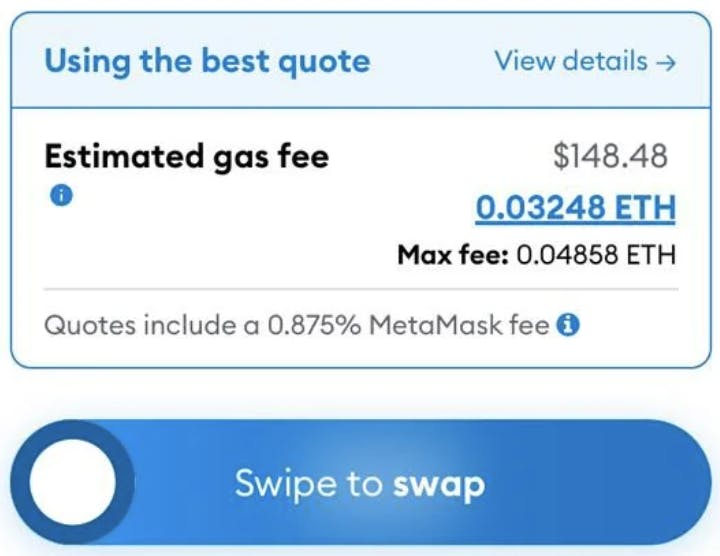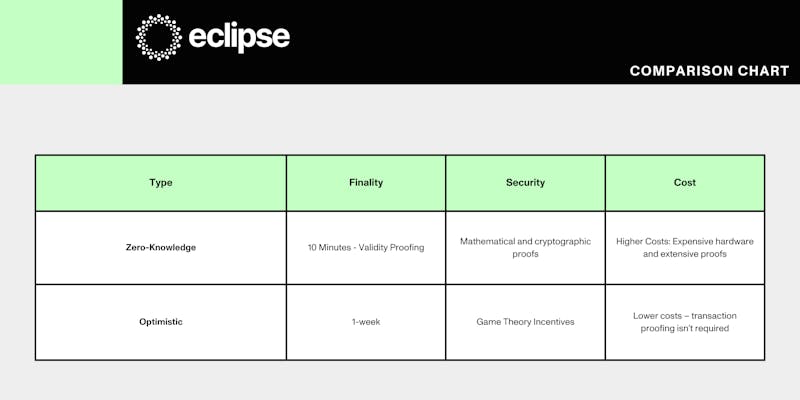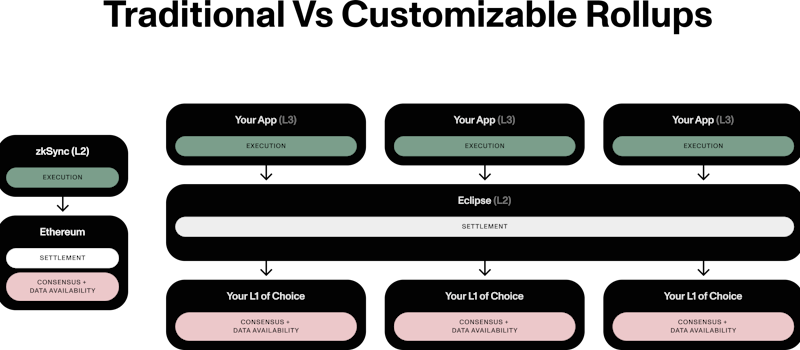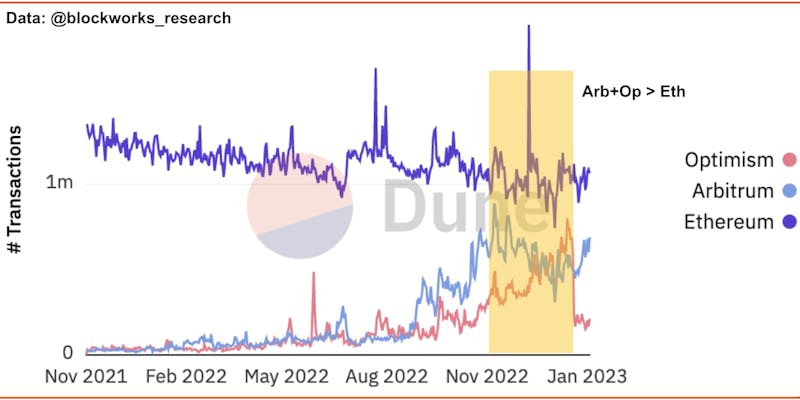What is a Rollup? A Beginners Guide - Eclipse
2023-04-17 • Vishruth Madhusudhan, Arjun Mohan, Pearce Seabrook
The TLDR
- Rollups help blockchains scale by taking transactions off-chain while maintaining the security and trust of the layer-1 chain.
- There are two primary types of rollups, Optimistic and Zero-Knowledge, which have different advantages and disadvantages
- Rollups are still early with a lot of progress still being made. For a period of time Optimism and Arbitrum transactions surpassed mainnet Eth transactions showing the potential rollups have for the overall ecosystem.
Intended Audience
- Individuals familiar with the basics of crypto but non-technical
- Individuals interested in delving into the world of DeFi and background processes
What is a Rollup?
A rollup is a layer-2 (L2) scaling solution that lowers congestion by taking transactions off-chain. In a rollup, multiple transactions are bundled and recorded as a single transaction on the main blockchain. This reduces the amount of data stored on-chain and increases the overall transaction throughput as well as efficiency. This approach allows for increased scalability and lower fees compared to traditional on-chain transactions while still preserving the trust and security of the original blockchain.

Figure 1 -- Simplified Rollup Visualization
Why do we need Rollups?
Ethereum alone has 2,700 dApps and over 230 million addresses. These numbers are expected to continue to grow with future blockchain adoption. The key constraint is that blockchains can only store a limited amount of transaction data before a new block has to be issued. This data limit is called blockspace. During periods of high demand, blockspace can become congested leading to more time until the transaction is complete and more expensive gas fees for users. Below is an example from a period of high usage in 2020 where it cost over $100 of gas to execute a transaction. Although gas is currently cheaper, further scaling solutions like rollups need to be implemented in order to scale blockchains to support greater adoption and additional functionality on-chain.

Figure 2 -- Expensive gas example transaction
How do Rollups Work?
Although there are various rollup constructions, all rollups take transactions off-chain.
“Smart contract rollups” accomplish this by processing groups of transactions off-chain then rolling multiple transactions into a single condensed transaction on-chain. Once the transaction is sent on-chain, the "settlement" process determines whether the transactions were computed correctly.
In contrast to smart contract rollups, sovereign rollups post only what transactions occurred to the layer-1 blockchain, but they do not perform the settlement process on the layer-1 blockchain. Instead, sovereign rollups pass additional proof to users of the blockchain with evidence that the transactions were executed correctly.
In the graphic above, there could be thousands of transactions between state 1 and 2 of the rollup, but that difference in state is recorded in one L1 transaction. By doing this, the L1 blockchain holds the history of transactions on the rollup, allowing those transactions to be backed by the security of the L1 blockchain. Depending on how this is done (which we will cover later), rollups can add value in multiple different ways on top of lowering congestion.
What are the Different Types of Rollups?
There are two types of rollups: optimistic vs. zero-knowledge (zk). In the next few sections we will cover what they are and the differences between them.
What are Optimistic Rollups?
Optimistic rollups submit transactions to the layer-1 blockchain without immediately providing proof that the execution was correct, and later allow "verifiers" to challenge the result. The main idea of this rollup is to construct a chain where the only constraint on throughput is execution speed, while adding only minimal additional trust assumptions. In this fraud proof system, verifiers and executors both stake coins as collateral and can both lose this money if the transaction was fraudulent or the verifier was wrong. For most optimistic rollups, in order to allow time for fraudulent claims to be processed, transactions won’t be finalized for roughly one week.
What are Zk-rollups?
Zk-rollups, aka zero knowledge rollups, assume a “guilty until proven innocent” philosophy where the transaction will be submitted only alongside evidence that the transaction was executed correctly. The "zero-knowledge proof" is a succinct representation that every step of executing the program followed the blockchain's rules. Zk-rollups combine many transactions together in a large batch which can be validated simultaneously..
The most prominent zk-rollups like zkSync, Scroll, and StarkEx have received over $1 billion in funding. The primary advantages of zk-rollups over optimistic is the quicker transaction finality, although due to the higher cryptographic load, they are harder to program and require more expensive hardware to run so they are generally used for use cases where the quicker finality and increased security are valued more.

Figure 3 -- ZK vs. Optimistic
What are Customizable Rollups?
The monolithic architecture is the classic structure of blockchains where execution, consensus, data availability, and settlement all happened on the L1. Modular architecture replaces this to provide more scalable chains with the use of L2s. This structure splits up the components of a blockchain to give rise to more specialized projects. For example zk-rollups are generally superior to any monolithic blockchain in terms of execution scalability, but applications built on them are still limited by the monolithic chains settlement, consensus and data availability. Modular rollups are a newly developed form of rollups that offers end users a more customizable architecture by separating settlement and data availability from consensus so that users can select the settlement and data availability provider which best fits their use case.

Figure 4 -- Comparison of Eclipse (Customizable Rollup) vs. zkSync
Eclipse is an example of a modular rollup which allows applications to configure a customizable solution to best fit their needs including gas fees and access. For settlement, Eclipse plans to offer optimistic or ZK-proofs depending on the developer’s preference. What differentiates modular rollups is the data availability & consensus, and Eclipse allows applications to choose between multiple high performance options depending on what is the best fit for the application. Modular rollups, like Eclipse, free applications from the constraints of major blockchains and allow them to optimize their own rollups solution around their product.

Figure 5 -- Optimism and Arbitrum translation volume over time vs. mainnet Ethereum
What's the Current State of Rollups?
Rollups are still in development and the space is growing. Rollups are L2 solutions, which means, to use them capital has to be bridged off-chain. This is acceptable for most users because it allows them access to the benefits and protocols built on the rollup, but if users want to use L1 protocols or a different rollup, they have to bridge back and potentially bridge again to a different rollup. For the overall ecosystem each rollup silos capital to its specific ecosystem decreasing net capital efficiency by limiting composability of assets. Going forward, solutions focusing on interoperability will help address this issue.
Conclusion
Rollups are a solution to the blockchain scaling problem. Significant funding has led to the development of cutting-edge solutions in the rollup space. Each solution allows applications to scale to a size beyond what is allowed by L1s. There is currently funding and focus on supporting infrastructure to address issues of interoperability and onboarding to rollups. Rollups represent a significant step forward for the space and are here to stay.
About Eclipse
Eclipse is a customizable rollup provider allowing developers to “pick and choose” the best aspects of blockchain technology needed to create unique decentralized applications, without making technical trade-offs.
Join their community: https://linktr.ee/eclipsefnd
Blockchain @ Georgia Tech
If you enjoyed this deep dive stay up to date with Blockchain at Georgia Tech’s upcoming events and posts by following us on Twitter and LinkedIn! Sign up for our newsletter here!